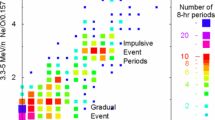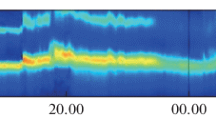Abstract
The solar wind provides a source of solar abundance data that only recently is being fully exploited. The Ion Composition Instrument (ICI) aboard the ISEE-3/ICE spacecraft was in the solar wind continuously from August 1978 to December 1982. The results have allowed us to establish long-term average solar wind abundance values for helium, oxygen, neon, silicon, and iron. The Charge-Energy-Mass (CHEM) instrument aboard the CCE spacecraft of the AMPTE mission has measured the abundance of these elements in the magnetosheath and has also added carbon, nitrogen, magnesium, and sulfur to the list. There is strong evidence that these magnetosheath abundances are representative of the solar wind. Other sources of solar wind abundances are Solar Energetic Particle (SEP) experiments and Apollo lunar foils. When comparing the abundances from all of these sources with photospheric abundances, it is clear that helium is depleted in the solar wind while silicon and iron are enhanced. Solar wind abundances for carbon, nitrogen, oxygen, and neon correlate well with the photospheric values. The incorporation of minor ions into the solar wind appears to depend upon both the ionization times for the elements and the Coulomb drag exerted by the outflowing proton flux.
Similar content being viewed by others
References
Aller, L. H.: 1986, in A. Dalgarno and D. Layzer (eds.), Spectroscopy of Astrophysical Plasmas, Cambridge University Press, Cambridge, p. 89.
Anders, E. and Grevesse, N.: 1989, Geochim. Cosmochem. Acta 53, 197.
Bahcall, J. N. and Ulrich, R. K.: 1988, Rev. Mod. Phys. 60, 297.
Bame, S. J., Asbridge, J. R., Felthauser, H. E., Glore, J. P., Hawk, H. L., and Chavez, J.: 1978, IEEE Trans. Geosci. Electronics GE-16, 160.
Bochsler, P.: 1989, J. Geophys. Res. 94, 2365.
Bochsler, P., Geiss, J., and Joss, R.: 1985, J. Geophys. Res. 90, 779.
Bochsler, P., Geiss, J., and Kunz, S.: 1986, Solar Phys. 103, 177.
Breneman, H. H. and Stone, E. C.: 1985, Astrophys. J. 299, L57.
Cameron, A. G. W.: 1982, in C. A. Barnes, D. D. Clayton, and D. N. Schramm (eds.), Essays in Nuclear Astrophysics, Cambridge University Press, Cambridge, pp. 23–43.
Coplan, M. A., Ogilvie, K. W., Bochsler, P., and Geiss, J.: 1978, IEEE Trans. Geosci. Electronics GE-16, 185.
Coplan, M. A., Ogilvie, K. W., Bochsler, P., and Geiss, J.: 1984, Solar Phys. 93, 415.
D'Annunzio, C. M., Ogilvie, K. W., and Coplan, M. A.: 1986, EOS 67, 1142.
Geiss, J. and Bochsler, P.: 1985, in Rapports Isotopiques dans le Système Solaire, Éditions Cepaudes, Paris, pp. 213–228.
Geiss, J., Hirt, P., and Leutwyler, H.: 1970, Solar Phys. 12, 458.
Geiss, J., Buhler, F., Cerutti, H., Eberhardt, P., and Filleux, C.: 1972, Apollo 16 Prelim. Sci. Report, NASA SP-315, p. 14–1.
Gloeckler, G. and Geiss, J.: 1989, AIP Proc. Cosmic Abundances Matter Symp. 183, 49.
Gloeckler, G., Ipavich, F. M., Studemann, W., Wilken, B., Hamilton, D. C., Kremiges, G., Hovestadt, D., Gliem, F., Lundgren, R. A., Rieck, W., Turns, E. O., Cain, J. C., MaSung, L. S., Weiss, W., and Winterhof, P.: 1985, IEEE Trans. Geosci. Remote Sensing GE-23, 234.
Grevesse, N.: 1984, Phys. Scripta T8, 49.
Hovestadt, D.: 1974, in C. T. Russell (ed.), Solar Wind III, Institute of Geophys. and Planetary Phys., University of California, Los Angeles, pp. 2–5.
Meyer, J. P.: 1979, in Les Eléments et Leurs Isotopes dans l'Universe, Institute d'Astrohysique, Liège, pp. 153–188.
Meyer, J. P.: 1985, Astrophys. J. Suppl. Ser. 57, 151.
Ogilvie, K. W., Coplan, M. A., Bochsler, P., and Geiss, J.: 1989, Solar Phys. 124, 167.
Ramaty, R. and Murphy, R. J.: 1987, Space Sci. Rev. 45, 213.
Ross, J. E. and Aller, L. H.: 1976, Science 191, 1223.
Schmid, J., Bochsler, P., and Geiss, J.: 1988, Astrophys. J. 329, 956.
Stone, E. C.: 1989, AIP Proc. Cosmic Abundances Matter Symp. 183, 72.
von Steiger, R. and Geiss, J.: 1989, Astron. Astrophys. 225, 222.
Author information
Authors and Affiliations
Rights and permissions
About this article
Cite this article
Coplan, M.A., Ogilvie, K.W., Bochsler, P. et al. Space-based measurements of elemental abundances and their relation to solar abundances. Sol Phys 128, 195–201 (1990). https://doi.org/10.1007/BF00154156
Received:
Revised:
Issue Date:
DOI: https://doi.org/10.1007/BF00154156




